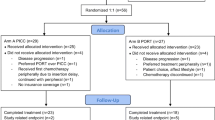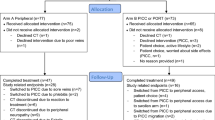Abstract
Importance
Systemic chemotherapy can be administered either through a peripheral vein (IV), or centrally through peripherally inserted central catheter (PICC), totally implanted vascular access devices (PORTs) or tunnelled cuffed catheters. Despite the widespread use of systemic chemotherapy in patients with breast cancer, the optimal choice of vascular access is unknown.
Objective
This systematic review evaluated complication rates and patient satisfaction with different access strategies for administering neo/adjuvant chemotherapy for breast cancer.
Evidence reviewed
Ovid Medline, EMBASE and the Cochrane Central Register of Controlled Trials were searched from 1946 to September 2017. Two reviewers independently assessed each citation. The Newcastle–Ottawa scale was used to assess the quality of cohort and case–control studies.
Findings
Of 1584 citations identified, 15 unique studies met the pre-specified eligibility criteria. There were no randomised studies comparing types of vascular access. Reports included six single-institution retrospective cohort studies, one retrospective multi-institution cohort, one retrospective cohort database study, five prospective single-institution studies, one prospective multi-institution study and one nested case–control study. Median complication rates were infection: 6.0% PICC (2 studies) versus 2.1% PORT (8 studies); thrombosis: 8.9% PICC (2 studies) versus 2.6% PORT (9 studies); extravasation: 0 PICC (1 study) versus 0.4% PORT (4 studies) and mechanical issues: PICC 3.8% (1 study) versus 1.8% PORT (9 studies). Satisfaction/quality of life appeared high with each device.
Conclusion
In the absence of high-quality data comparing vascular access strategies, randomised, adequately powered, prospective studies would be required to help inform clinical practice and reduce variation.
Similar content being viewed by others
References
Lipitz-Snyderman A, Elkin EB, Atoria CL, Sima CS, Epstein AS, Blinder V, Sepkowitz KA, Bach PB (2015) Provider differences in use of implanted ports in older adults with cancer. Med Care 53(7):646–652. https://doi.org/10.1097/mlr.0000000000000368
Lipitz-Snyderman A, Ma Q, Pollack MF, Barron J, Elkin EB, Bach PB, Malin JL (2015) Complications associated with use of long-term central venous catheters among commercially insured women with breast cancer. J Oncol Pract 11(6):505–510. https://doi.org/10.1200/jop.2015.004796
LeVasseur N, Stober C, Daigle K, Robinson A, McDiarmid S, Mazzarello S, Hutton B, Joy A, Fergusson D, Hilton J, McInnes M, Clemons M (2018) Optimising vascular access for patients receiving intravenous systemic therapy for early stage breast cancer—a survey of oncology nurses and physicians. Curr Oncol
LeVasseur N, Stober C, Ibrahim M, Gertler S, Hilton J, Robinson A, McDiarmid S, Fergusson D, Hutton B, Joy A, McInnes M, Clemons M (2018) Perceptions around vascular access for intravenous systemic therapy and risk factors for lymphedema in early stage breast cancer—a patient survey. Curr Oncol
Stokowski G, Steele D, Wilson D (2009) The use of ultrasound to improve practice and reduce complication rates in peripherally inserted central catheter insertions: final report of investigation. J Infus Nurs 32(3):145–155. https://doi.org/10.1097/NAN.0b013e3181a1a98f
Shojania KG, Duncan BW, McDonald KM, Wachter RM, Markowitz AJ (2001) Making health care safer: a critical analysis of patient safety practices. Evid Rep Technol Assess (Summ) 43(i–x):1–668
Saugel B, Scheeren TWL, Teboul JL (2017) Ultrasound-guided central venous catheter placement: a structured review and recommendations for clinical practice. Crit Care 21(1):225. https://doi.org/10.1186/s13054-017-1814-y
McMahon DD (2002) Evaluating new technology to improve patient outcomes: a quality improvement approach. J Infus Nurs 25(4):250–255
Cardella JF, Cardella K, Bacci N, Fox PS, Post JH (1996) Cumulative experience with 1273 peripherally inserted central catheters at a single institution. J Vasc Interv Radiol 7(1):5–13
Nichols I, Humphrey JP (2008) The efficacy of upper arm placement of peripherally inserted central catheters using bedside ultrasound and microintroducer technique. J Infus Nurs 31(3):165–176. https://doi.org/10.1097/01.NAN.0000317703.66395.b8
Association for Vascular Access Posiiton Statement: The Use of Seldinger or Modified Seldinger Technique, in combination with Real-Time Imaging Miodalities for Peripheral Inserted Central Catheter and Midline Placements by Clinicians (2011) Heriman, UT
AIUM practice parameter for the use of ultrasound to guide vascular access procedures (2012) Laurel, MD
McGowan J, Sampson M, Salzwedel DM, Cogo E, Foerster V, Lefebvre C (2016) PRESS peer review of electronic search strategies: 2015 guideline statement. J Clin Epidemiol 75:40–46. https://doi.org/10.1016/j.jclinepi.2016.01.021
Liberati A, Altman DG, Tetzlaff J, Mulrow C, Gotzsche PC, Ioannidis JP, Clarke M, Devereaux PJ, Kleijnen J, Moher D (2009) The PRISMA statement for reporting systematic reviews and meta-analyses of studies that evaluate healthcare interventions: explanation and elaboration. BMJ 339:b2700. https://doi.org/10.1136/bmj.b2700
Wells GSB, O’Connell D, Peterson J, Welch V, Losos M, Tugwell P (2013) The Newcastle–Ottawa Scale (NOS) for assessing the quality of nonrandomised studies in meta-analyses. http://www.ohri.ca/programs/clinical_epidemiology/oxford.asp
Singh KR, Agarwal G, Nanda G, Chand G, Mishra A, Agarwal A, Verma AK, Mishra SK, Goyal P (2014) Morbidity of chemotherapy administration and satisfaction in breast cancer patients: a comparative study of totally implantable venous access device (TIVAD) versus peripheral venous access usage. World J Surg 38(5):1084–1092. https://doi.org/10.1007/s00268-013-2378-x
Curigliano G, Balduzzi A, Cardillo A, Ghisini R, Peruzzotti G, Orlando L, Torrisi R, Dellapasqua S, Lunghi L, Goldhirsch A, Colleoni M (2007) Low-dose aspirin for the prevention of venous thromboembolism in breast cancer patients treated with infusional chemotherapy after insertion of central vein catheter. Support Care Cancer 15(10):1213–1217. https://doi.org/10.1007/s00520-007-0277-0
Soliman AA, Csorba R, Ullrich A, Tsikouras P, Rath W, von Tempelhoff GF (2014) Antiphopholipid antibodies and functional activated protein C resistance in patients with breast cancer during anthracycline-based chemotherapy administered through an intravenous port-catheter device. Clin Appl Thrombos Hemost 20(3):338–340. https://doi.org/10.1177/1076029613508598
Kriegel IEM, Guillaume A, Goater P, Asselain B, Queinnec M et al (2005) Prospective study comparing Broviac cuffed catheter and implantable vascular access device for adjuvant and neoadjuvant chemotherapy for breast cancer: infectious and mechanical risks. J Clin Oncol 23(16_Suppl):8114
Nas OF, Hacikurt K, Kaya A, Dogan N, Sanal B, Ozkaya G, Dundar HZ, Erdogan C (2017) Choosing the appropriate side for subcutaneous port catheter placement in patients with mastectomy: ipsilateral or contralateral? Radiol Med 122(6):472–478. https://doi.org/10.1007/s11547-017-0736-8
Debourdeau P, Espie M, Chevret S, Gligorov J, Elias A, Dupre PF, Desseaux K, Kalidi I, Villiers S, Giachetti S, Frere C, Farge D (2017) Incidence, risk factors, and outcomes of central venous catheter-related thromboembolism in breast cancer patients: the CAVECCAS study. Cancer Med 6(11):2732–2744. https://doi.org/10.1002/cam4.1201
Lefebvre L, Noyon E, Georgescu D, Proust V, Alexandru C, Leheurteur M, Thery JC, Savary L, Rigal O, Di Fiore F, Veyret C, Clatot F (2016) Port catheter versus peripherally inserted central catheter for postoperative chemotherapy in early breast cancer: a retrospective analysis of 448 patients. Support Care Cancer 24(3):1397–1403. https://doi.org/10.1007/s00520-015-2901-8
Ma LI, Liu Y, Wang J, Chang Y, Yu L, Geng C (2016) Totally implantable venous access port systems and associated complications: a single-institution retrospective analysis of 2996 breast cancer patients. Mol Clin Oncol 4(3):456–460. https://doi.org/10.3892/mco.2016.726
Zhou J, Qian S, He W, Han G, Li H, Luo R (2014) Implanting totally implantable venous access port via the internal jugular vein guided by ultrasonography is feasible and safe in patients with breast cancer. World J Surg Oncol 12:378. https://doi.org/10.1186/1477-7819-12-378
Harrold K, Martin A, Gale S (2015) Proactive placement of peripherally inserted central catheters. Br J Nurs 24(14):S16–S17. https://doi.org/10.12968/bjon.2015.24.Sup14.S16
Pardo I, Rager EL, Bowling MW, Fajardo A, Clare S, Goulet R Jr (2011) Central venous port placement: a comparison of axillary versus anterior chest wall placement. Ann Surg Oncol 18(2):468–471. https://doi.org/10.1245/s10434-010-1353-0
Gandhi RT, Getrajdman GI, Brown KT, Gandras EJ, Covey AM, Brody LA, Khilnani N (2003) Placement of subcutaneous chest wall ports ipsilateral to axillary lymph node dissection. J Vasc Interv Radiol 14(8):1063–1065
Kreis H, Loehberg CR, Lux MP, Ackermann S, Lang W, Beckmann MW, Fasching PA (2007) Patients’ attitudes to totally implantable venous access port systems for gynecological or breast malignancies. Eur J Surg Oncol 33(1):39–43. https://doi.org/10.1016/j.ejso.2006.08.003
Marcy PY, Magne N, Castadot P, Bailet C, Macchiavello JC, Namer M, Gallard JC (2005) Radiological and surgical placement of port devices: a 4-year institutional analysis of procedure performance, quality of life and cost in breast cancer patients. Breast Cancer Res Treat 92(1):61–67. https://doi.org/10.1007/s10549-005-1711-y
Study of Palbociclib Alone and in Combination in Patients With Relapsed and Refractory (R/R) Leukemias. https://ClinicalTrials.gov/show/NCT03132454
Randomized Trial Standard of Care Vascular Access Strategies for (Neo)Adjuvant Trastuzumab-based Breast Cancer Treatment. https://ClinicalTrials.gov/show/NCT02632435
REaCT-vascular Access Her2 Negative Vascular Access Strategies for (Neo) Adjuvant Breast Cancer Treatment Without Trastuzumab. https://ClinicalTrials.gov/show/NCT02688998
Stevens V, Geiger K, Concannon C, Nelson RE, Brown J, Dumyati G (2014) Inpatient costs, mortality and 30-day re-admission in patients with central-line-associated bloodstream infections. Clin Microbiol Infect 20(5):O318–O324. https://doi.org/10.1111/1469-0691.12407
Acknowledgements
Internal funding was used for this study from the Rethinking Clinical Trials (REaCT) program.
Funding
Funding for this study was through the Rethinking Clinical Trials (REaCT) program.
Author information
Authors and Affiliations
Corresponding author
Ethics declarations
Conflict of interest
BH consults for Cornerstore Research. All other authors have nothing to disclose.
Ethical approval
Ethics approval was not required for this systematic review.
Informed consent
Informed consent was not required for this systematic review.
Electronic supplementary material
Below is the link to the electronic supplementary material.
Rights and permissions
About this article
Cite this article
Robinson, A., Souied, O., Bota, A.B. et al. Optimal vascular access strategies for patients receiving chemotherapy for early-stage breast cancer: a systematic review. Breast Cancer Res Treat 171, 607–620 (2018). https://doi.org/10.1007/s10549-018-4868-x
Received:
Accepted:
Published:
Issue Date:
DOI: https://doi.org/10.1007/s10549-018-4868-x




